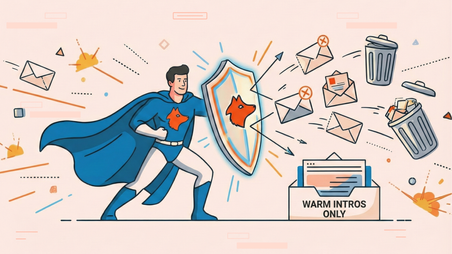Cold Email Then & Now: Lessons from 2022 vs. 2025

In 2022, cold email success was measured in opens. If someone clicked your subject line, it felt like a win.
But by 2025, an open isn’t enough. The inbox is noisier than ever, filters are tighter, and attention spans are shorter.
Today, the true goal of outreach isn’t just to be seen—it’s to be heard.
Cold email’s real purpose is to start conversations, and that means earning replies.
So how did we get here? And what does it mean for founders trying to connect with the right people?
Summary
What are the biggest takeaways from looking at cold email in 2022 vs. 2025?
- 2022 focused on opens: Success judged on subject lines and open rates (<30%).
- 2025 focused on replies: Opens don’t matter if no conversation follows—reply rate (avg. 4.1%) is the only metric that counts.
- Noise is higher: Inboxes are crowded; relevance and trust are now the differentiators.
- Small > big: Campaigns ≤100 contacts get ~3x more replies than mass blasts.
- Trust matters: Custom domains + no tracking pixels = higher credibility and response.
- Follow-ups work (in moderation): 2–3 thoughtful nudges, not endless chasing.
- AI is acceptable: Use it to speed up, but always add human context.
Stop chasing vanity metrics. Send fewer, better emails that start real conversations.
2022 vs 2025 Cold Emailing Stats
The data speaks for itself. Cold emailing has gotten harder, and the numbers add up:
| Theme | 2022 (Then) | 2025 (Now) | Takeaway for Founders |
|---|---|---|---|
| Core Metric | Open rates dominate | Replies are the true goal | Stop chasing opens—measure conversations |
| Difficulty | Outreach felt harder for most | Inboxes even noisier, competition higher | Relevance beats volume |
| Personalization | Basic: subject lines, names, merge tags | Contextual: pain points, achievements, referrals | Depth > surface-level |
| Campaign Size | Bigger lists seen as better | ≤100 contacts get ~3x more replies | Small, focused > mass blast |
| Trust Factors | Rarely discussed | Custom domains, no tracking pixels improve replies | Set up properly, look legit |
| Follow-ups | 2–3 follow-ups doubled responses | Still critical, but too many = unsubscribes/spam | Limit to 2–3, add value |
| Tools & Data | Many still manual or using spreadsheets | Tools + AI common, but misused | Tech helps, but strategy wins |
| Timing | Weekday vs weekend debated | Timing largely irrelevant | Focus on message, not clock |
| Inbox Outcome | Success = being noticed | Success = starting conversations | The reply is what matters |
A cold email’s purpose is not to be opened. It’s to start a conversation. Let's look closer at what that means.
2022 Cold Emails: The Age of Opens
Back in 2022, Hunter surveyed hundreds of professionals about their cold email habits. The big takeaway: open rates dominated the conversation.
- Opens were the key metric: Over half of respondents reported open rates under 30%, while only a tiny minority managed above 80%.
- Subject lines were king: Personalizing subject lines gave a clear boost, but nearly 40% of people didn’t personalize at all.
- Follow-ups doubled results: Sending two or three follow-ups often made the difference between silence and engagement.
- Tools were underused: Almost half weren’t using any automation, relying on spreadsheets and manual sends.
For many founders, this meant celebrating small wins—an email opened, a subject line tested.
But focusing on opens is like celebrating someone walking into your shop without ever buying anything.
2025 Cold Emails: The Age of Replies
Fast forward to 2025. Cold email has not only survived but grown in importance. Decision-makers still prefer email over calls or LinkedIn. But the numbers tell a sobering story:
- Reply rates average just 4.1%: That means 96% of cold emails go unanswered.
- Smaller is smarter: Campaigns with 50 or fewer recipients get triple the reply rates of mass blasts.
- Relevance is everything: 71% of decision-makers say most cold emails aren’t relevant to them.
- Trust signals matter: Using a custom domain instead of webmail makes a noticeable difference in replies.
- AI is fine—if used well: People don’t care if AI helped draft an email, as long as it feels thoughtful and personal.
In short: if 2022 was about being noticed, 2025 is about being trusted. The winners are the founders who cut through the noise with relevant, human-sounding messages.
The Founder’s Cold Email Playbook Cheatsheet (2025 Edition)
If you’re short on time, here’s the quick playbook:
- Stop chasing opens: Measure replies and conversations instead.
- Keep lists small: Target 50 highly relevant people, not 500 strangers.
- Personalize beyond the name: Mention their wins, pain points, or shared context.
- Set up for trust: Use a custom domain. Skip spammy tracking pixels.
- Follow up with value: Two or three thoughtful nudges are enough. Referral asks are especially effective.
- Use AI wisely: Let it speed up research and drafts, but always have a human guiding the AI writer's direction.
Final Thought: Make Your Leads Count
Time is scarce. Chasing open rates is wasted effort when what really matters is starting meaningful conversations.
It’s better to send 20 carefully chosen emails that earn two replies than 200 generic ones that earn none.
Cold email hasn’t died—it’s evolved. From 2022 to 2025, the playbook shifted from vanity metrics to real outcomes.
The next wave of growth will belong to the founders who understand this: success isn’t about being seen, it’s about being answered.




 Send cold emails with Hunter
Send cold emails with Hunter